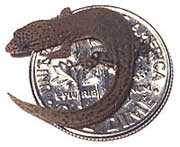
In 1998, Paul F. Hoffman and Daniel P. Schrag at Harvard University put forth a chilling description of earth’s climate some 650 million years ago. Their theory, dubbed snowball earth, held that between 750 million and 580 million years ago, ice repeatedly enveloped our planet, coating the seas from pole to pole and killing off early life almost completely. During the past few years, the idea has stirred up a great deal of debate. And new data published in the December issue of Geology only furt

World’s smallest reptile is discovered in the Caribbean forest.
At just 16 mm from nose to tail, the Jaragua lizard is the world’s smallest. In fact, it’s the smallest vertebrate that can reproduce on dry land 1 .
The newly discovered lizard lives on Isla Beata, a small, forest-covered island in the Caribbean off the Dominican Republic. Blair Hedges, an evolutionary biologist at Pennsylvania State University, together with Richard Thomas of the

A balanced portfolio of programs could mean a faster quantum computer.
Strategies from the world of finance could help get the best out of quantum computers, say US researchers 1 . The right portfolio of programs could solve a problem many times faster than a single strategem.
Quantum computers – purely hypothetical as yet – would be fast, but you could never be sure whether a program was going to work or not. You would have to keep running the program until

Radon may pose a greater cancer threat than has been thought.
Radon damage from irradiated cells spreads to their neighbours, a new study finds 1 . The result suggests that small amounts of this radioactive gas could cause widespread harm.
The study “is a reason for concern but not panic”, says Gerhard Randers-Pehrson of Columbia University, New York, a member of the team that performed the study. “We’re talking about the acceptable level of radon changing pe

The question of which forces control terrestrial ecosystems lies at the heart of a long-standing debate among ecologists. One theory, the so-called bottom-up theory, suggests that plant defense mechanisms exert control by limiting food availability for herbivores. Top-down theorists, however, suggest that predators limit the numbers of herbivores and hence their impact on the vegetation. Now new findings in the current issue of the journal Science that describe animal communities isolated for 15 year

For more than 150 years, people around the world have made ample use of the explosive trinitrotoluene, otherwise known as TNT. Its use has had unintended consequences, however: the manufacture, storage and disposal of TNT—which ranks among the most toxic explosives employed by the military—have left large areas of land contaminated and polluted. So far, effective and affordable cleanup technologies have remained out of reach. But new research suggests that help may come from what might seem an unlike

At the Berlin synchrotron radiation source BESSY II, the largest magnetic anisotropy of a single molecule ever measured experimentally has been determined. The larger this anisotropy is, the better a…

LSU quantum researchers uncover hidden quantum behaviors within classical light, which could make quantum technologies robust. Understanding the boundary between classical and quantum physics has long been a central question…

One of the biggest mysteries in science – dark energy – doesn’t actually exist, according to researchers looking to solve the riddle of how the Universe is expanding. For the…

A team led by plant biotechnologist Prof Markus Schwarzländer from the University of Münster and biochemist Prof Bruce Morgan from Saarland University has developed new biosensors with which the ratio…

How deubiquitinases USP53 and USP54 cleave long polyubiquitin chains and how the former is linked to liver disease in children. Deubiquitinases (DUBs) are enzymes used by cells to trim protein…

Conceptual blueprint to analyze experimental catalyst data. Machine learning (ML) models have recently become popular in the field of heterogeneous catalyst design. The inherent complexity of the interactions between catalyst…

How simulations help manufacturing of modern displays. Modern materials must be recyclable and sustainable. Consumer electronics is no exception, with organic light-emitting diodes (OLEDs) taking over modern televisions and portable…

“Neurons that fire together, wire together” describes the neural plasticity seen in human brains, but neurons grown in a dish don’t seem to follow these rules. Neurons that are cultured…

The quest for sustainable energy solutions has been a major focus of scientific research for decades. Solar energy, a clean and renewable source, has emerged as a promising alternative to…

Pacific Northwest National Laboratory to contribute leadership to national effort in microelectronics design and development. Microelectronics run the modern world. Staying ahead of the development curve requires an investment that…

With a processing speed a billion times faster than nature, chip-based laser neuron could help advance AI tasks such as pattern recognition and sequence prediction. Researchers have developed a laser-based…

New technology could remotely identify various types of plastics, offering a valuable tool for future monitoring and analysis of oceanic plastic pollution. Researchers have developed a new hyperspectral Raman imaging…